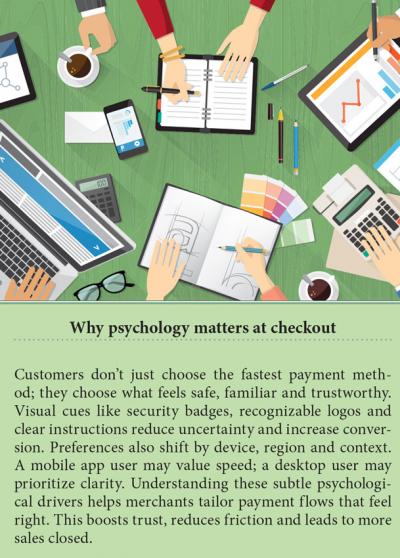The Green Sheet Online Edition
July 28, 2025 • 25:07:02
The psychology of payment choice: Tips to boost conversion

As tap-and-go checkouts and one-click purchases become more widespread, it’s easy to assume convenience always wins. But payment choices are often guided by less obvious forces, such as the need for reassurance, a sense of control or the confidence that comes with a process that works the way they expect. Psychology plays a much bigger role than many merchants realize.
More than 200 alternative payment methods (APMs) are now recognized. Some are mobile-first; others are region-specific or tailored to unbanked populations. Yet despite the variety, consumer behavior tends to follow patterns. Understanding those patterns, along with the motivations behind them, can give businesses a meaningful edge.
It starts with what feels safe
Merchants often think of checkout optimization in terms of speed and simplicity. And those things matter. But in practice, what feels fast is often what feels intuitive or predictable. Customers gravitate toward payment methods they recognize, particularly in high-stakes environments like online shopping, where security and trust are top-of-mind.
A recent study by analytics software provider FICO found that only 35 percent of UK consumers consider real-time payments (RTP) more secure than credit cards, and nearly a quarter aren’t sure RTP includes enough security checks at all (see bit.ly/4lEvo4D). While usage is growing, confidence clearly lags behind. This perceived trustworthiness often trumps logic.
For acquirers, PSPs and ISOs helping merchants scale, recognizing the gap between what’s secure and what feels secure is essential. Checkout flows that foreground familiar payment methods or reassure users with visible clear indicators of legitimacy, such as logos, encryption badges or refund policies, tend to outperform those that rely solely on novelty or speed.
The psychology of payment choice also varies depending on the device or channel. A customer paying through a mobile app may prioritize speed, while someone shopping via desktop might be more focused on entering details securely.
In physical stores, habits around card or mobile wallet use are often influenced by the environment: is it busy, contactless-friendly or low trust? Knowing these situational differences enables merchants to adjust their payment experience to better reflect how customers engage in specific environments or with certain devices.
One experience doesn’t fit all
Localization is more than language translation. What counts as a normal payment flow in one market may feel alien in another. In some regions, cash use remains culturally embedded. In others, mobile-first experiences dominate. For instance, research from The Payments Association shows that younger UK consumers still use cash regularly, not out of preference, but out of habit or access issues (see bit.ly/4kScLcr).
Merchants expanding into new geographies need to match their payment options to local expectations. That might mean offering QR-based payments in parts of Asia, or bank transfers in markets where trust in cards is low. A one-size-fits-all approach to payments isn’t just inefficient; it risks alienating users altogether.
And when merchants overlook local nuances, the cost isn’t limited to abandoned carts. It can lead to a rise in support tickets, higher chargeback rates and, in some markets, even regulatory complications. A smoother, locally attuned checkout flow reduces those risks and strengthens long-term customer relationships. Checkout psychology is subconscious Consumers don’t always know why they prefer one method over another. They may say they want fast payments but still opt for cards or PayPal over account-to-account (A2A) options. Why? Because those methods feel known. They're embedded in habit. And habit often beats out logic.
The challenge for merchants and payment providers is to remove unnecessary doubt from the process. Confusing design, unclear instructions and unfamiliar interfaces all introduce uncertainty. Once doubt creeps in, abandonment isn’t far behind.
This is why simplicity must be paired with reassurance. A checkout that feels right to consumers is one that flows as expected, shows clear confirmation steps and presents trusted options first. Psychology, not just UX, determines whether a transaction completes.
Incentives shift behavior
When introducing new payment methods, particularly those that lower fees like A2A, merchants can’t rely on the tech alone to drive uptake. Incentives work. A PYMNTS Intelligence and Amazon Web Services study showed that 40 percent of U.S. consumers who haven’t used A2A would try it if it came with a reward. Among younger groups, that number exceeds 60 percent (see bit.ly/4lzkz3S).
Merchants can use this insight tactically. Trial discounts for A2A payments. Offer loyalty points. Make the benefit clear up front—faster refunds, lower fees, exclusive access—and track how adoption changes over time.
The commercial upside of psychological insight
This isn’t academic. It’s commercial. Failed transactions cost merchants money. So do abandoned carts, chargebacks, and customer churn caused by confusion or mistrust. Understanding why a customer makes the choices they do at checkout isn’t a soft science. It’s a hard lever for improving performance.
I work with businesses in emerging and established markets to identify what matters to their customers at the moment of payment. Often, it’s not what merchants expect. It’s what customers feel and whether that feeling is enough to complete the sale.
When merchants align their payment stack with real customer preferences; and acquirers, ISOs, and PSPs support that alignment; the result is often better performance across conversion, satisfaction and retention.
Recognizing the psychology behind payment decisions is key to building checkout experiences that are not only functional but also trusted and effective. For merchants and payment professionals, the next wave of optimization won’t just come from new tools. It will come from better alignment with how people think and feel when they pay—and a willingness to adapt those insights into every transaction, in every market. 
Zaki Farooq is CTO and co-founder of PayFuture, www.payfuture.net, the local payments connector for emerging markets. Contact him via LinkedIn at linkedin.com/in/zakifarooq.
Notice to readers: These are archived articles. Contact information, links and other details may be out of date. We regret any inconvenience.





